There are hundreds of bee species recorded in Georgia.
We have listed the most common bees you may encounter from the most popular to the least popular. Continue reading to find out more about the bees in Georgia.
The most common bees you may encounter in Georgia include:
Table of Contents
1. Eastern Carpenter Bee
The Eastern Carpenter Bees (Xylocopa virginica) nest in different woods, eating pollen and nectar. Unlike other bees, dominant females are responsible for reproduction, foraging, and nest construction, while subordinates are responsible for guarding the nest.
These bees are a similar size to a bumblebee. Their glossy bodies are mostly black with some purple tints. Females have wider heads and males have longer bodies. Males have a white spot on their faces.

2. Common Eastern Bumble Bee

The Common Eastern Bumble Bee (Bombus impatiens) is often encountered in eastern North America in temperate forest areas. They are encountered in the country, suburban and urban areas. They are excellent pollinators.
Their hair is short, their heads are medium size and their bodies are long and rectangular. Queens and workers are similar in color and structure. Queens grow to 23mm with workers growing to 18mm in body length.
Queens and workers are both black with a yellow thorax and first abdominal segment. The males have a yellow head and face.
3. Western Honey Bee
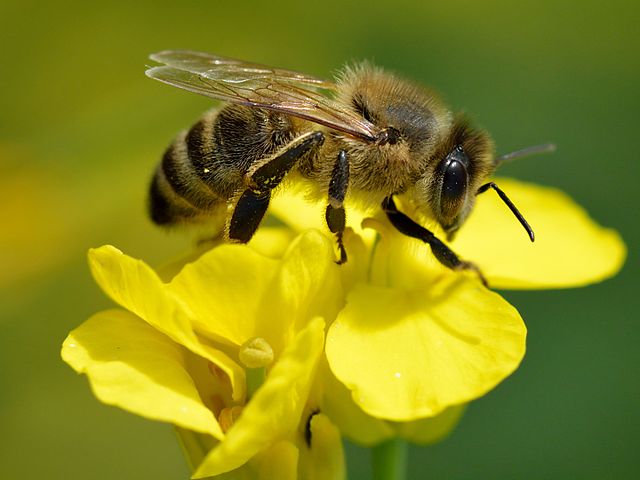
The Western Honey Bee (Apis mellifera) is a common honey bee found throughout the world. They create colonies with a single fertile female, non-reproductive females, and some males. A single colony can be home to tens of thousands of bees.
They are domesticated insects, maintained by beekeepers for their honey production and pollination activities. Humans have introduced this bee throughout the world, except Antarctica.
4. American Bumble Bee

The American Bumble Bee (Bombus pensylvanicus) is a threatened species, native to North America. The population has dropped by ninety percent in the past twenty years. These bees live and nest in open farmlands and fields, feeding on food plants, including clovers and sunflowers.
These bees have a yellow thoracic dorsum, black and white alternative tergal segments, and a black posterior. There are short hairs on their malar spaces. Large queens grow to 26mm in body length with workers at 19mm in body length.
These bees forage up to 1.5 miles from the nest. Nests are mostly found in long grass or underground. They use hay or long grass to create sheltered nests, just above the ground. Some nests may be found in burrows, old bird nests, rodent burrows, and crevices. They also make nests in human objects, such as barns and buckets.
5. Brown-belted Bumble Bee

Brown-belted Bumble Bees (Bombus griseocollis) are native to the United States. Queens grow to 23mm in body length with a black face and head with some yellow hairs. They have a yellow thorax and a yellow and black banded abdomen with a black posterior and legs.
Workers grow to around one centimeter in length and are similar in color, but they have a brown/yellow band that goes around their abdomen. Males grow to 1.9cm in length with large eyes. Their face and thorax have yellow hairs and a yellow, brown, and black abdomen.
6. Two-spotted Bumble Bee

The Two-spotted Bumble Bee (Bombus bimaculatus) is a social bumble bee that can be encountered in Georgia. These bees have two yellow spots on the abdomen. They are excellent pollinators, foraging on a wide variety of plants.
There is the only size that differentiates the queen from the workers. Queens have black faces with a triangular patch of yellow hairs. They have a yellow thorax and black venter, there are also yellow hairs on the legs.
Males have black and yellow hairs on their faces. Workers grow to 16mm in body length with males growing to 14.5mm and queens growing to 22mm.
7. Sculptured Resin Bee

The Sculptured Resin Bee (Megachile sculpturalis), also known as the giant resin bee, is a leaf cutting bee. They grow to 22mm in males, 25mm in females. They are larger than other leafcutters.
Their cylindrical bodies are mostly black, shiny, and hairless. They have transparent wings, black head, and yellow to brown on their thorax. Males have a squared abdomen, while females have a pointed abdomen.
These bees nest around wooden structures, such as decks, porches, and doors.
8. Carpenter-mimic Leaf cutter Bee

The Carpenter-mimic Leaf cutter Bee (Megachile xylocopoides) belongs to the Megachilidae family and was first described in 1853. They are often encountered in Georgia and easy to identify with their black base color, iridescent blue wings, and tan-colored wings.
They are common in suburban neighborhoods.
9. Brown-winged Striped Sweat Bee

The Brown-winged Striped Sweat Bee (Agapostemon splendens) is a small bee, with females being metallic green with dark wings. Females grow to 10mm and males to 11mm. The males have thickened hind femora. They are more common from April to October when they visit a variety of flowers.
10. Pure Green-Sweat Bee

The Pure Green-Sweat Bee (Augochlora pura) is a solitary bee, known for its bright green coloration. They forage in a variety of plants, living in rotting logs. They are also known for licking the sweat from human skin.
Males and females are similar in size, around 8mm in body length. Their bodies are bright green and shiny. Males tend to be more blue than females, though telling a male and female apart is not easy.
These bees are mostly active from February to November, nesting in rotting wood in woodpiles and forests. They don’t forage far from the nest.
11. Southern Carpenter Bee
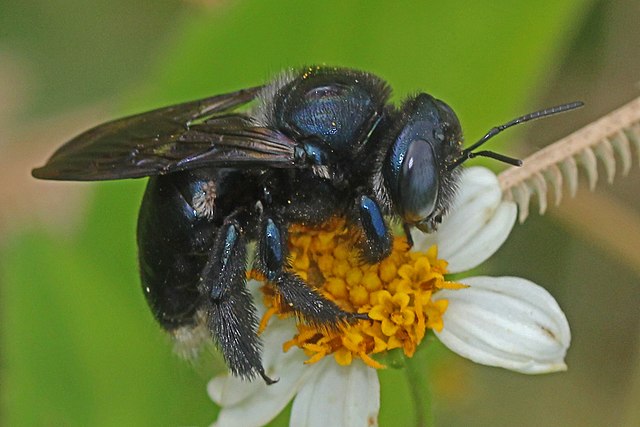
The Southern Carpenter Bee (Xylocopa micans) is mostly found in coastal and gulf regions. They nest in woody plants, though they are not known to build nests in structural timbers, which means they are less of a pest to humans.
These are solitary bees and do not live in a colony. They are large and can grow to 19mm in body length with metallic black bodies with blue to green colored patches. Males have bright yellow hairs on their scutum and scutellum.
They excavate woody plant material to make nests, usually in dead wood of any plant species.
12. Flat-tailed Leaf-cutter Bee

Flat-tailed leafcutter bees (Megachile mendica) cut leaves to line their nests. These are black bees with large eyes, covered in white hairs.
They are excellent pollinators, visiting numerous flowers. These are solitary bees; they do not form colonies. They construct individual nests, tunneling into dead twigs and rotting trees.
13. Hibiscus Turret Bee
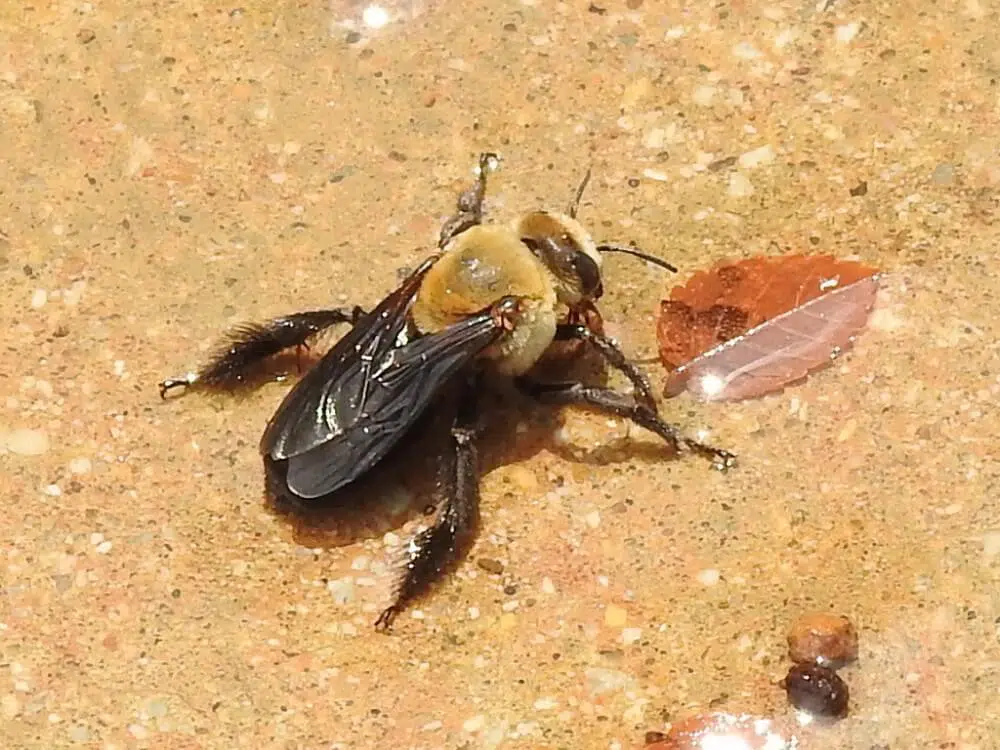
The Hibiscus Turret Bee (Ptilothrix bombiformis) can grow to 17.5mm in body length. They are ground-nesting bees and solitary, which means they do not form colonies.
These bees have prominent hairs on their hind legs, which helps them gather pollen to provision their nest. Males and females are similar in size and both can be observed from June to August.
14. Bicolored Striped Sweat Bee

The Bicolored Striped Sweat Bee (Agapostemon virescens) belongs to the Halictidae family, common in North America. Males have slender hind femora, while females have black abdomens.
These bees are mostly observed from April to October as they visit flowers, being important pollinators of wildflowers.
15. Poey’s Furrow Bee

Poey’s Furrow Bees (Halictus poeyi) belong to the Halictidae family. They have well-defined basal hair bands and robust heads. Males have pale antennae. They are mostly observed from February to November, as they visit flowers from a range of families, helping with pollination.
16. Ligated Furrow Bee
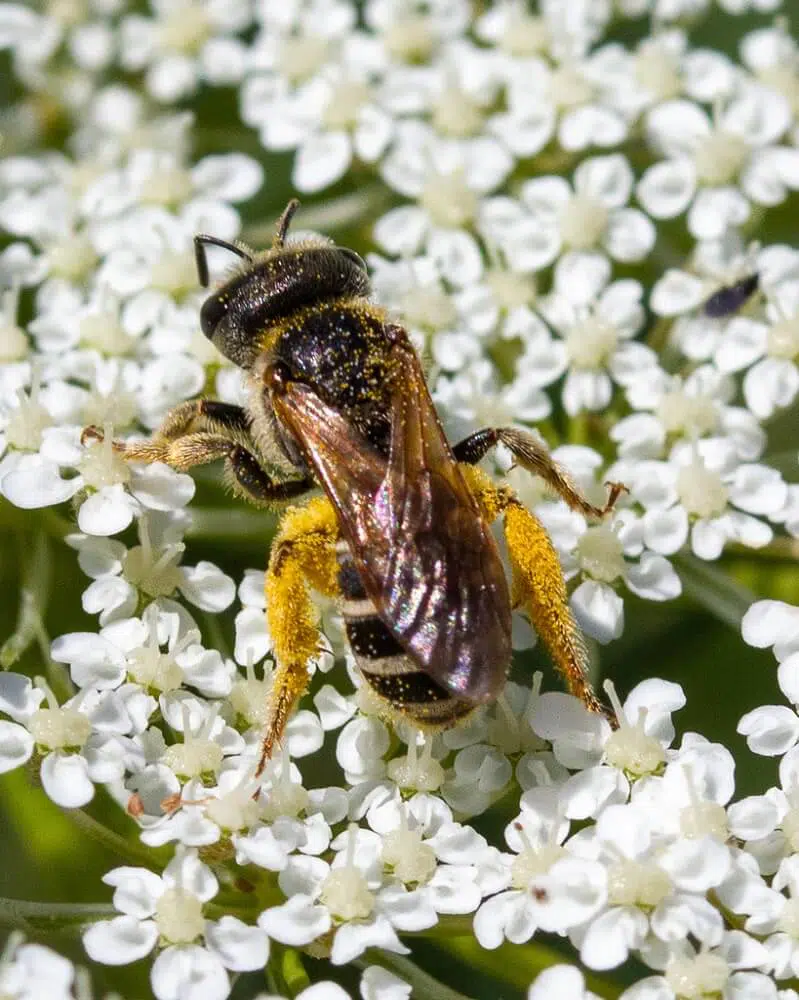
The Ligated Furrow Bee (Halictus ligatus) mines or burrows into the ground, creating nests. They are eusocial bees and are very aggressive within their colony. They are mostly black or black/brown with faint metallic patches.
The queens are large-bodied, which maximizes their energy reserves. This enables them to overwinter, reproduce independently and establish nests. The helpers are smaller with undeveloped ovaries.
17. Two-spotted Longhorn Bee

The Two-spotted Longhorn Bee (Melissodes bimaculatus) has long antennae and varies in coloration. This species has two spots on the end of the abdomen, which are light in color, standing out against its black body. The hind legs have long yellow hairs, which look like pollen, the hairs help trap pollen from the flowers that they visit.
These are relatively common bees and are seen in spring and early summer, as they collect pollen from a range of flowers. They seem to prefer agricultural fields, feeding on the blossoms of coneflowers, legumes, mallows, and asters.
18. Southern Plains Bumble Bee

The Southern Plains Bumble Bee (Bombus fraternus) is an endangered species, native to the United States. These bees are mostly black with yellow banding on the abdomen and thorax. It is larger than other bumblebee species.
The queens can grow to 27mm in body length with workers growing to 19mm. They are similar in appearance. Females’ bodies are covered in yellow and black hairs. Males can grow to 25mm with very long antennae. Their coloration is similar to the females with the area between the wings being yellow.
19. Nimble Ceratina
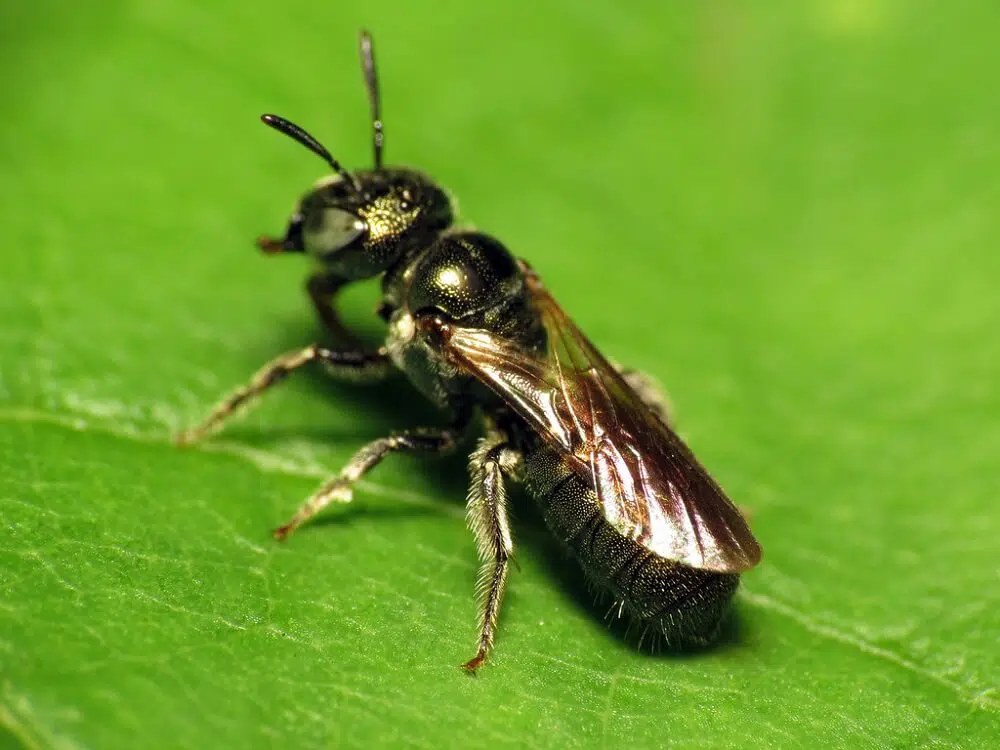
The Nimble Ceratina (Ceratina strenua) is a carpenter bee common in Georgia. They are not large with females growing to 6.5mm and males to 5.5mm in body length. These bees have a white or yellow stripe on their front tibia.
They are common in meadows and forest edges from March to October where they visit flowers and plants, playing an important role in wildflower pollination.
20. Taurus Mason Bee
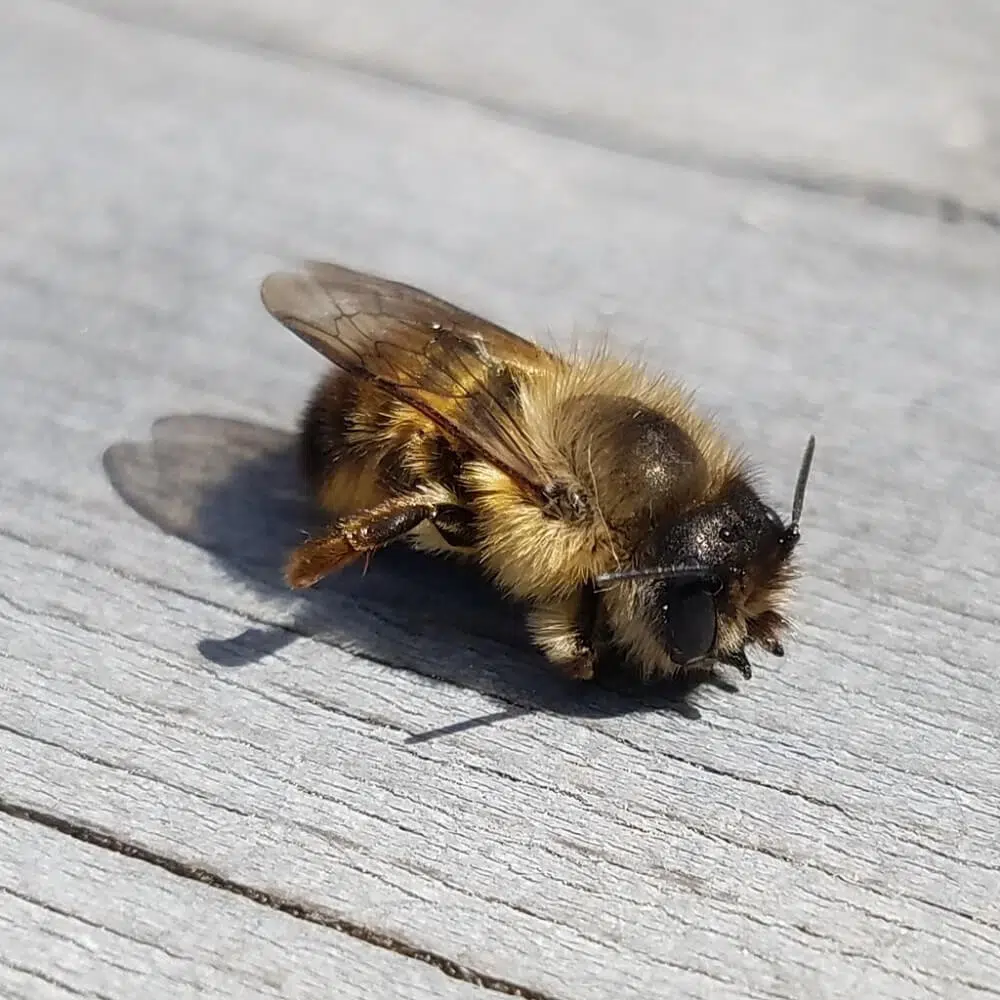
The Taurus Mason Bee (Osmia taurus) is found in Georgia, covered in yellow hairs with large eyes and transparent wings. They are black bees with yellow and black hairs on their face and the yellow hairs, that cover the body are long.
Males have a green metallic tone to their abdomens. Females can grow to 12mm with males growing to 11mm.
21. Bristle Sweat Bee

The Bristle Sweat Bee (Lasioglossum imitatum) is often seen licking the sweat from human skin. These are small bees growing to 5mm in body length for females and 4.3mm for males. The bristle sweat bee is common in Georgia between April and October, seen visiting flowers from a variety of families.
22. Blueberry Digger Bee
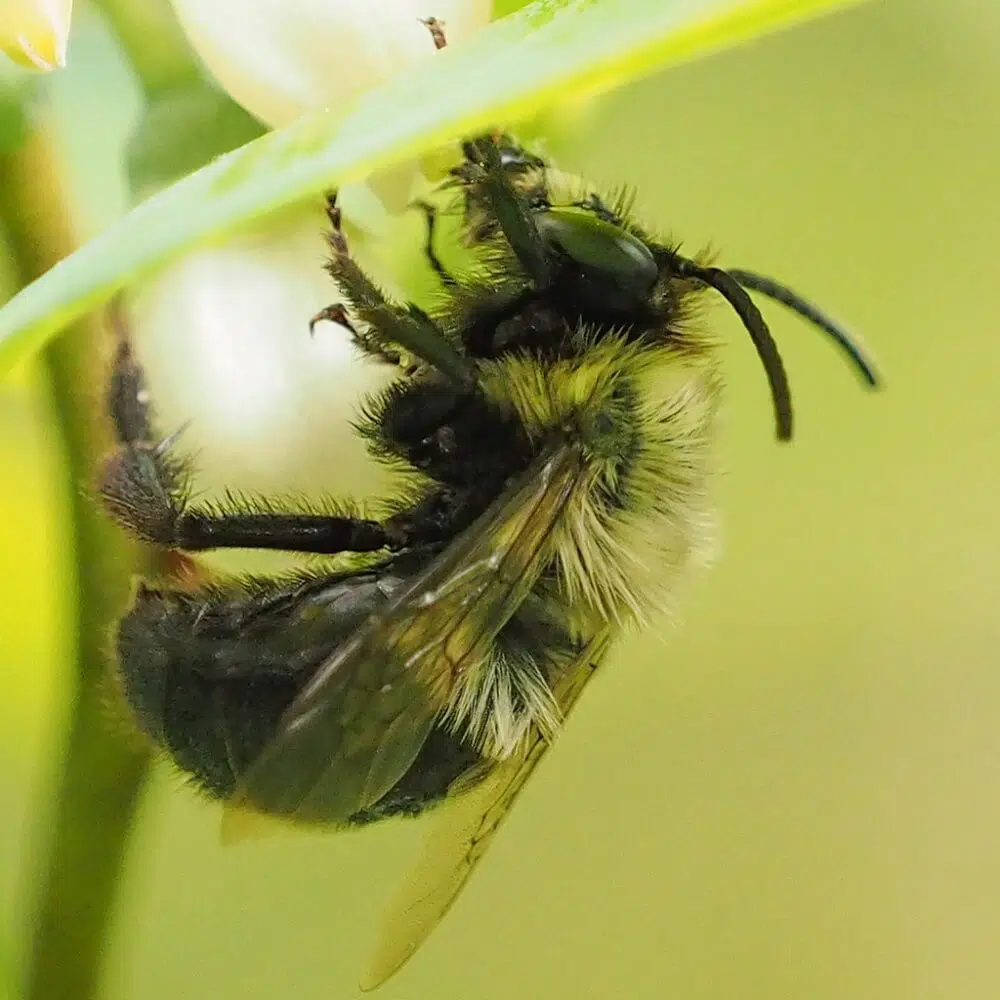
The Blueberry Digger Bee (Habropoda laboriosa) is an excellent pollinator of blueberries. It is believed that each female will visit close to fifty thousand blueberry flowers in her lifetime, helping to produce more than six thousand blueberries.
Females grow to 16mm, while males grow to 14mm in body length. They are common in early spring where they collect nectar and pollen primarily from blueberries.
23. Brown-winged Sweat Bee

The Brown-winged Sweat Bee (Lasioglossum fuscipenne) is also known as the dark-winged sweat bee, belonging to the Halictidae family. These are black bees with yellow banding on their abdomens. They do not have hairs and their abdomens are shiny.
They have dark transparent wings and hairs on their hind legs, which are used to collect pollen as they move from one flower to the next.
24. Oblique Longhorn
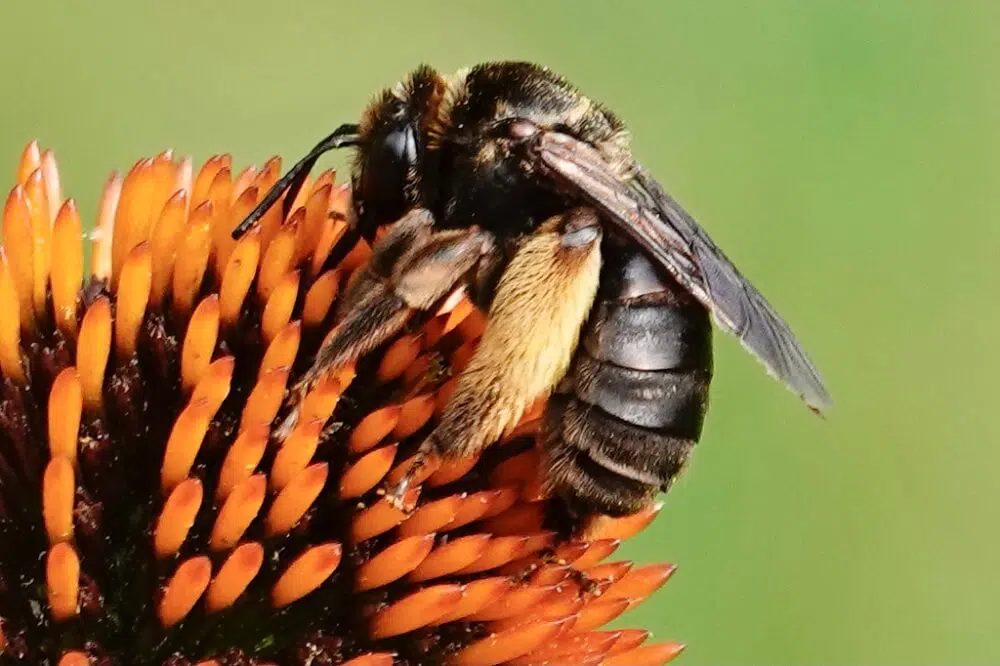
The Oblique Longhorn (Svastra obliqua) is a heavy set and shaggy bee, known for its preference for sunflowers. They are common from late summer to fall, which helps you identify them, against other long-horned bees. Most longhorns will be common in spring and early summer, but this bee emerges later.
They prefer grassland habitats where they assist with the pollination of wildflowers. They are solitary and do not form colonies. They build their nests in the ground, though they are known to build nests close to each other. Some females will share nests.
They are often referred to as the sunflower bee, though they also help with daisy and gaillardia flowers. Some species are known to be specialist pollinators of evening primrose and cactus.
25. Lemon Cuckoo-Bumble Bee

The Lemon Cuckoo-Bumble Bee (Bombus citrinus) is a lemon-yellow color, native to North America. They invade other bumblebee colonies, killing the resident queen and taking control of the workers.
Before raiding a nest, the queen lemon cuckoo bumble bee forages a number of plants. Plants she visits include mountain mints, snakeroot, and goldenrods.
26. Calliopsis Cuckoo Nomad Bee

The Calliopsis Cuckoo Nomad Bee (Holcopasites calliopsidis) is found in Georgia. They build shallow nests in hard-packed soil. These bees have interesting coloration. They are hairless with a black body and red to orange colored hairs, which forms bands on the abdomen.
They have transparent wings and large eyes. There are sparse white hairs covering the face, belly, and thorax.
27. Modest Masked Bee

The Modest Masked Bee (Hylaeus modestus) or yellow-faced bee is found in Georgia, with females and males both growing to 7mm. They are more common from May to September when they visit numerous flower families, helping with pollination.
This black bee can be identified by the yellow mask on its face, which runs between the eyes. There are some yellow patches on the first abdominal segment and some yellow on the legs. They have dark, transparent wings.
28. Orange-legged Furrow Bee

The Orange-legged Furrow Bee (Halictus rubicundus) is a sweat bee which was introduced to North America. They have different social behaviors, based on their climate. They are solitary in higher elevations while forming colonies in lower elevations.
They are not metallic, which sets them apart from other sweat bees. Females can grow to 1cm and are brown with white bands on their abdominal segments. Females have rust orange legs.
Males are slender with long antennae and yellow markings on their faces and legs.
29. Confusing Furrow Bee

The Confusing Furrow Bee (Halictus confusus) or southern bronze furrow bee is a eusocial bee, found in open habitats in Georgia. They can grow to 7mm in body length with females having a green head and thorax, which darkens to black on the abdomen with green highlights.
The females’ legs are black and become red. Males, on the other hand are similar, but they have more red in their wings and their legs have yellow stripes.
30. Carpenter-mimic Cuckoo-leaf-cutter
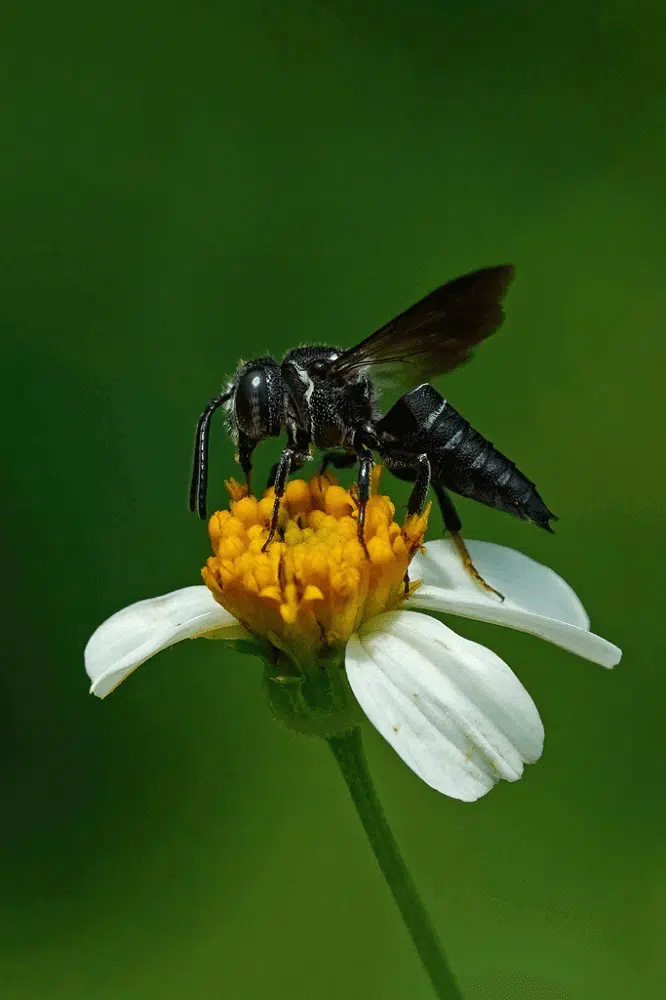
The Carpenter-mimic Cuckoo-leaf-cutter (Coelioxys dolichos) belongs to the Megachilidae family. Females can grow to 15mm with males growing to 12mm. These black bees have thin white abdominal stripes with a patch of longer white tufts at their first abdominal segment.
There is a white mask on their face, which is made of short white hairs. They have dark wings, which are lighter at the body, darkening closer to the tip. They are mostly observed from March to November, where they visit a range of floral families.
31. Louisiana Painted-Dark Bee
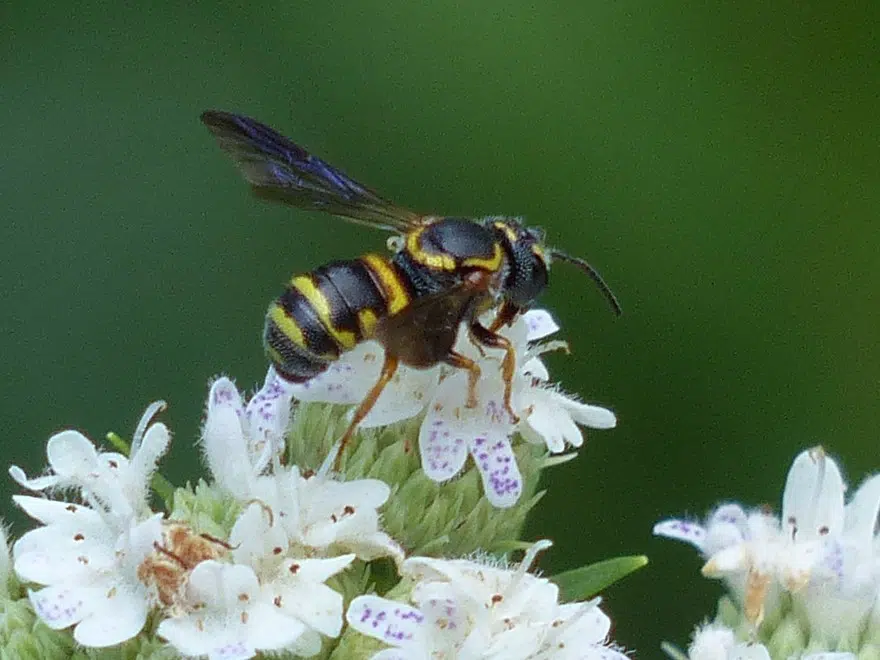
The Louisiana Painted-Dark Bee (Stelis louisae) is an attractive bee, first described in 1911. They are active from March to September, where you can see them on sunflowers.
These are black bees with striking yellow coloration. They have four patches on their heads, the thorax is bordered with a thin yellow border and their abdomen has irregular yellow bands.
The front pair of legs are yellow, with the remainder being black with yellow. They have dark transparent wings with black antennae.
32. Pruinose Squash Bee
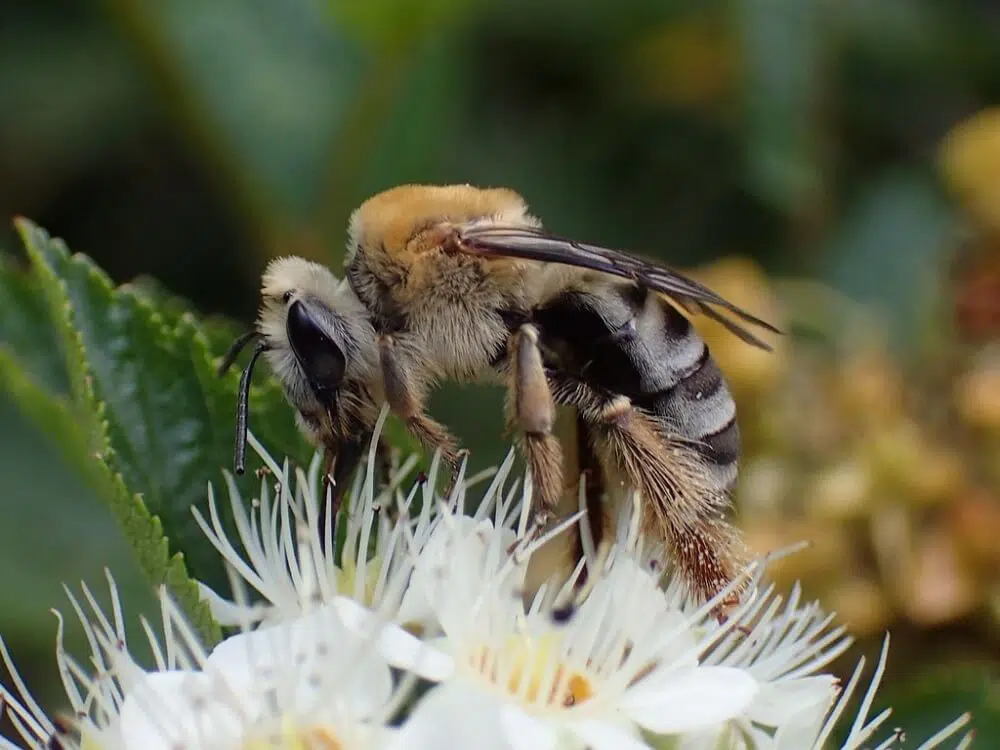
The Pruinose Squash Bee (Peponapis pruinosa) is a long-horned bee. It is a pollinating specialist for a handful of host plants, including squashes and gourds. These bees can grow to 14mm in body length with a wide abdomen, which is black with white banding and yellow hairs.
They have branched hairs on their hind legs, helping them carry pollen. The males do not collect pollen. These bees rely on wild and cultivated gourds, squashes, pumpkins, and other related plants.
Females dig nests in the ground, never too far from the host plants. They are important pollinators, where they will spend their entire life in an irrigated crop field.
33. Metallic Epauletted-Sweat Bee
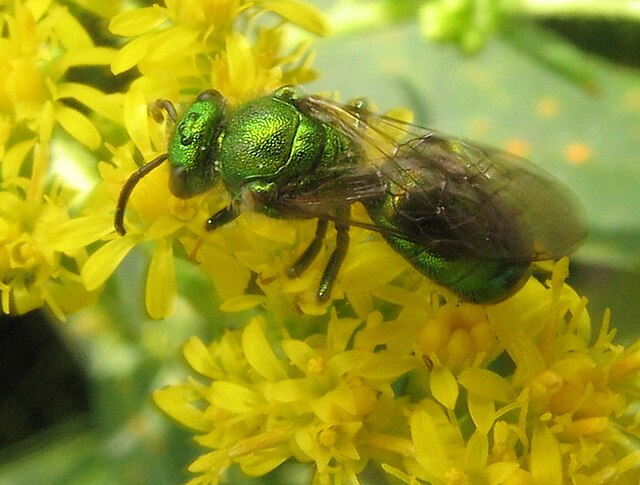
The Metallic Epauletted-Sweat Bee (Augochloropsis metallica) can grow to 9mm in body length. They are known for their stunning metallic green body. They are uniformly metallic green with the shade of green varying from one bee to the next.
There are tiny white hairs covering the body and thicker tufts of white on the legs. Some have some black banding on their abdomens. They have large eyes, black antennae, and dark, transparent wings.
They are common from March to November, where they visit numerous flower families, aiding in pollination.
34. Norton’s Nomia
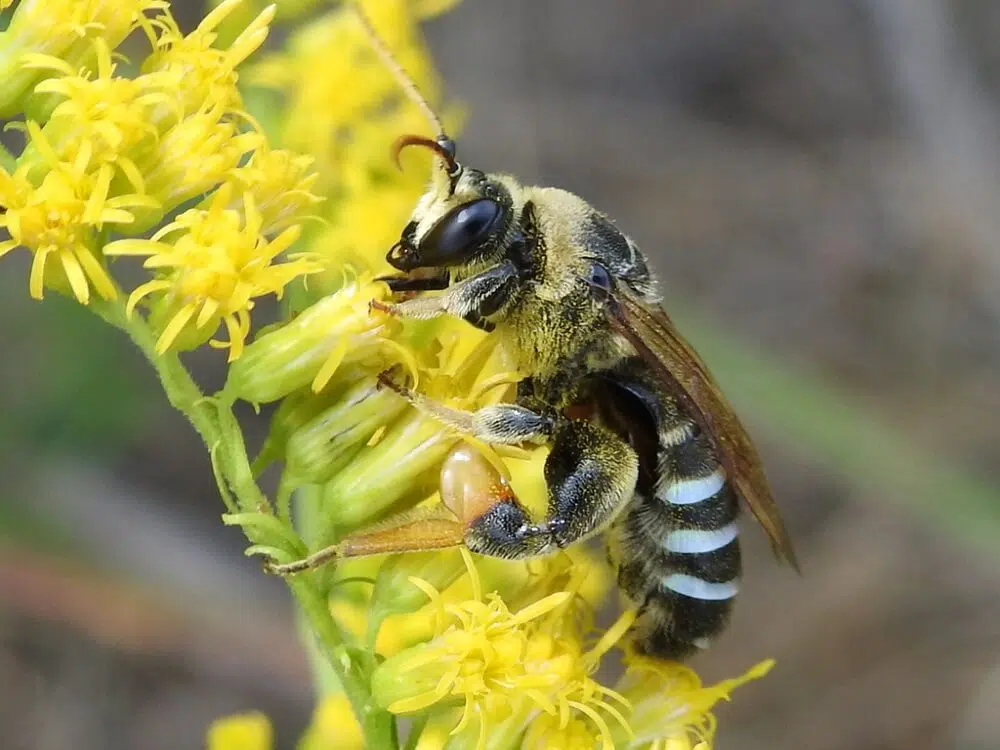
Norton’s Nomia sweat bee (Nomia nortoni) is a bee that is known for licking the sweat from human skin. Females can grow to 16mm with males being larger at around 22mm. These black bees have three distinct green/yellow bands on their abdomens.
These bees are more common late in the season, from July to November, where they take pollen from a range of flowers, including sweet peppers and sunflowers.
35. Alfalfa Leaf cutter Bee

The Alfalfa Leaf cutter Bee (Megachile rotundata) is a European bee, which was introduced to North America and is often seen in Georgia. They are solitary bees, which do not form colonies or store honey, but they are excellent pollinators of some frigs, vegetables, including carrots and alfalfa.
They are used by farmers to assist in pollination. Females construct and provision their own nest, usually build in logs or old trees. The nests are lined with cut leaves.
They are known to bite and sting if threatened. These are small bees, which grow to around 9mm in body length. Males are slightly smaller than females with different marketings.
These bees are dark gray in color with females being covered in white hairs over their bodies and males having white and yellow spots on their abdomens.
36. Black-and-gold Bumble Bee
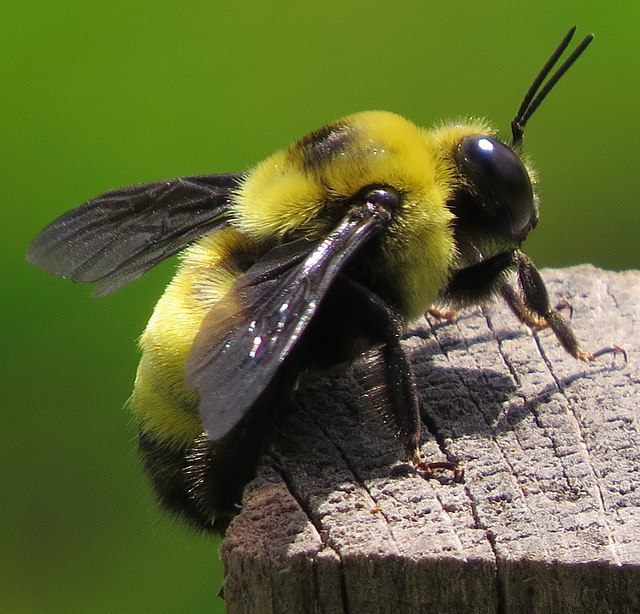
The Black-and-gold Bumble Bee (Bombus auricomus) is one of the largest bumble bee species. They are large-bodied with short body hair. The thorax is black with some yellow hairs.
The first abdominal segment is black with the second and third segments being yellow, along with black at the tip. They build nests above the ground in open habitats, such as grasslands, where they feed on clovers, bergamot, and thistles, to name a few.
The queen can grow to 25mm with workers and males growing to 20mm in body length. This is a late-emerging species, helping you identify it easier.
Further Readings: